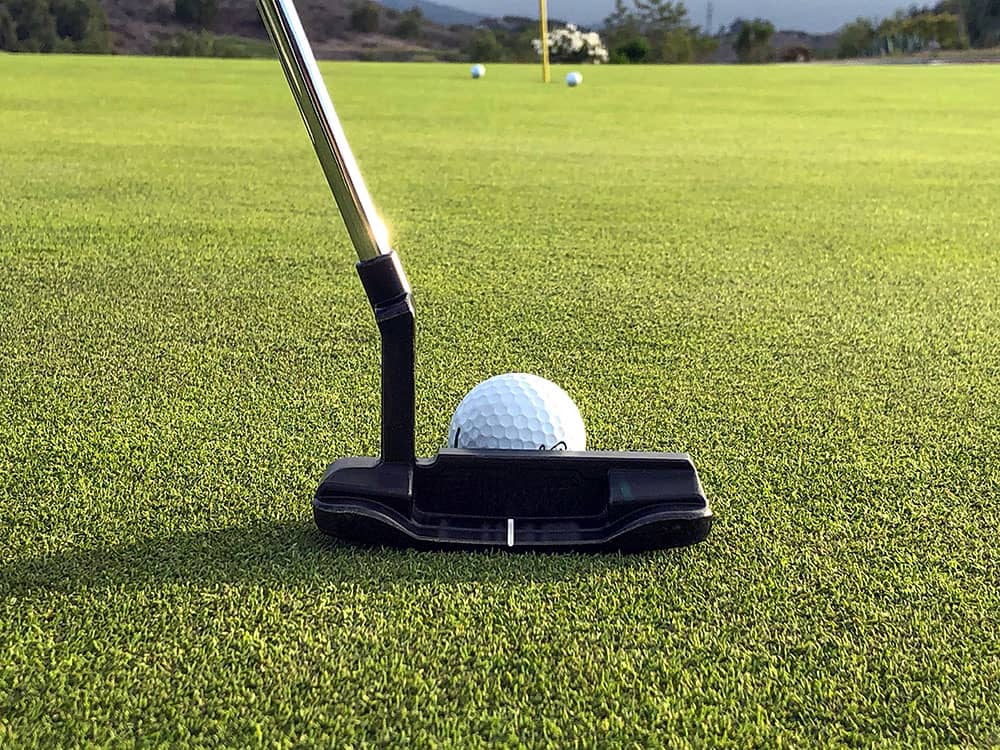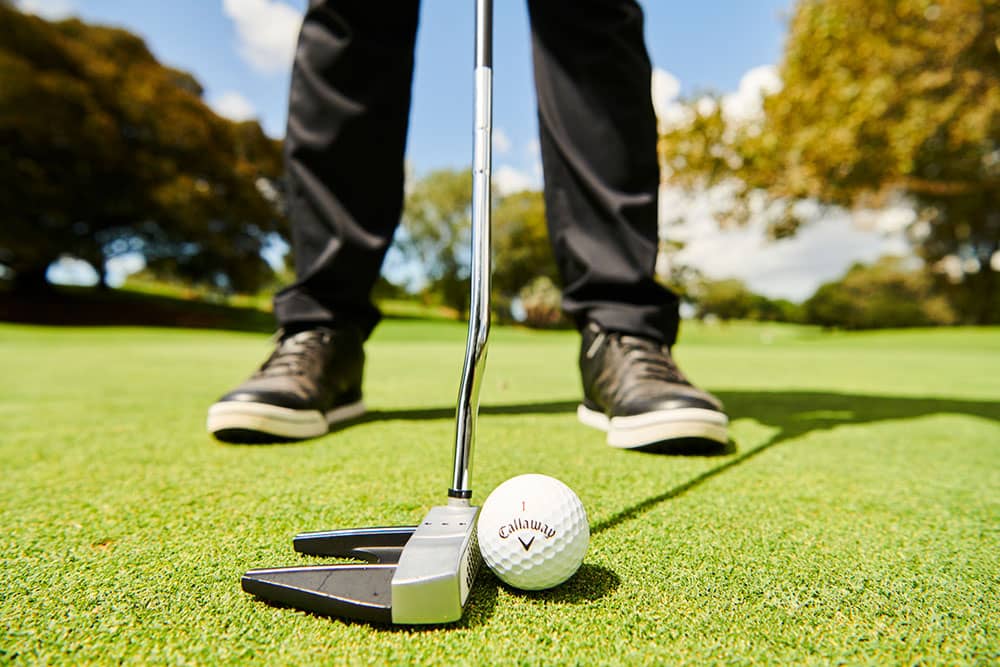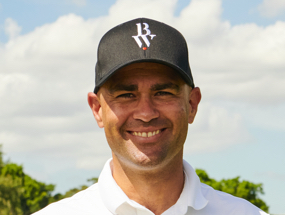Hitting great tee shots is important, but your short game is critical for lowering your score.
Given the importance of your short game, it is key to find a putter that feels good to you and has features that complement your stroke. Mallet putters and blader putters are the two most common putter head styles.
Whether you are a beginner golfer or a seasoned pro, we put together a guide to blade putters and mallet putters to help you choose the right putter for your game.
What Is a Blade Putter?
Blade putters feature a traditional head shape that is often preferred by ‘purists’
Blade putters feature heavy toe-weighting and a sweet spot near the heel. This makes blade-style putters well-suited for golfers with an arc-style putting stroke.
In general, blade putters tend to be lighter than mallet putters, allowing an increased chance for the clubface to turn or twist at impact. This can cause off-centre hits in higher handicap golfers or players who lack precision.
Blade style putters at a glance:
- Favoured among professional golfers and golf purists
- Thinner than mallet putters
- Clubhead does not extend back as far as mallet head designs
- Heavily toe-weighted
- Heel sweet spot
- Have remained almost completely the same over the years
- Typically lighter than mallet putters
Who Are Blade Putters Best For?
- Lower handicap players
- ‘Feel players’ who want precision and control
- Golfers with an arc-type putting stroke
- Golfers who feel solid in their putting stroke and confident in their alignment
Pros of a Blade Putter:
- Excellent feel
- Works nicely on fast greens
- Consistency on impact
- Easier for controlling speed and distance
- Excellent for improved putting accuracy
Cons of a Blade Putter:
- Slightly harder to line up (typically, a blade putter’s alignment line will be around an inch long)
- Less forgiving than a mallet putter
What Is a Mallet Putter?
Modern mallet putters typically feature a larger head, slightly heavier weight, and a vast range of sizes and shapes.Given their size and the way their weight is concentrated away from the clubface, many golfers prefer the balance and stability mallet-style putters offer.
Mallet putters often have a larger sweet spot and can help prevent twisting of the clubface during your stroke. Most of the weight is concentrated low and toward the back of the clubhead, making it ideal for golfers who are trying to increase their consistency. The mallet putter’s weight helps keep the ball lined up and on path.
Originally, mallet putters came in a semi-circle shape. Having evolved immensely over the years, you can now find mallet-style putters in a variety of designs. Each year, mallet-style putters become easier to customise.
Mallet style putters at a glance:
- Larger sweet spot than blade-style putters
- Have evolved over time leading to various shapes and styles
- Offer additional alignment aid
- Have more prominent features than blade-style putters
- The traditional mallet putter looked like a semi-circle coming out of the back of the golf club. The mallet putters have since evolved to include many additional shapes.
- Generally heavier than blade putters, although the extensive range of designs means that certain mallet putters and blade putters can be the same weight
Who Are Mallet Putters Best Suited To?
Mallet-style putters are ideal for:
- Beginner golfers
- Higher handicap golfers
- Golfers who often find it difficult to hit putts hard enough (the heavier weight of the mallet putter can help give you the increased force you need to get shots to go further)
- Golfers looking for a putter style with the most forgiveness
- Golfers who have a straight back and straight-through type of swing (a mallet putter’s alignment, weight, and size are not as beneficial if you swing in an arc)
- Golfers who struggle with alignment issues (mallet putters offer longer alignment lines that are easier to utilise than blade-style putters)
- Golfers who want to improve their short game and gain confidence
- Golfers who prefer different designs and colours in their bag
Pros of a Mallet Putter:
- More forgiving than a blade putter
- Easier to align
- Better for learning distance control
- Available in a wide variety of designs (the mallet’s larger head space allows for more room to add stamping, colours, or other creative touches)
- Can be easily customised
- Can be purchased in centre-shafted models
Cons of a Mallet Putter:
- Doesn’t always perform as well on fast greens
- Not ideal for players with an arc-style stroke
What Is the Most Forgiving Putter?
Mallet putters are generally considered more forgiving than blade putters. This increased forgiveness is attributed to their larger size and weight distribution.
The weight distribution of mallet putters provides a larger sweet spot and allows players to get away with less precision when putting.
What Is the Difference Between Toe-Balanced and Face-Balanced Putters?
Toe-balanced putters allow a higher chance for the clubface to open and close during your stroke. This makes toe-balanced putters better suited to golfers with an arc-style stroke.
Face-balanced putters rely on the centre of gravity to decrease the putter’s chance to open and close during your stroke. Golfers with a straighter putting stroke style usually prefer face-balanced putters.
Should I Use a Blade or Mallet Putter?
Typically, choosing between a blade and mallet putter comes down to feel, preference, and your unique stroke. As with all of your golf clubs, it is best to test several styles of putters to find the one that works best for you.
What Is the Best Putter Style For Beginners?
There is no hard and fast rule when it comes to the best putter style for beginner golfers. However, a mallet putter is generally recommended as the best putter for beginners.
If you purchase a set of clubs that includes a blade putter, don’t worry. Give it a try and see what you think. With time, you’ll be able to adjust to the blade style and may even find you prefer it.
As a beginner, try different putter sizes and styles and find out which one offers you the best feel, most control, and ideal level of forgiveness.
Am I Using the Wrong Putter?
Here are some signs to watch for that may be you are using the wrong type of putter:
- Your short game lacks consistency
- You often miss putts
- Your putts often come up short
Should I Get A Putter Fitting?
Many golfers select a putter style based on feel and this often works just fine. Still, a custom putter fitting may help you find a putter style that complements your playing level and abilities.
A putter fitting isn’t necessary, but you may benefit from a putter fitting if you are:
- A beginner golfer
- Struggling with your short game
- Outside of the traditional height range for standard putters
- Looking to increase your confidence in your short game
What About Putter Grip Size and Style?
Along with choosing between mallet putters and blade putters, it’s time to experiment to determine which putting grip style is right for you.
Looking for More Golfing Tips?
Choosing the right golf equipment is imperative to your game, but we know the options can be overwhelming.
Ultimately, much of the choice between “mallet vs. blade” putters comes down to personal preference. If you can, try out different putter styles to find the look, weight, and feel that works best for you.
Want to transform other aspects of your golf game? Gain confidence with my customised online coaching, my online golf academy, or in-person golf lessons in Sydney.Whether you are a brand new golfer or an experienced pro, I’m here to help you build your skills and enjoy the game more. Reach out today with any questions or for personalised advice.




